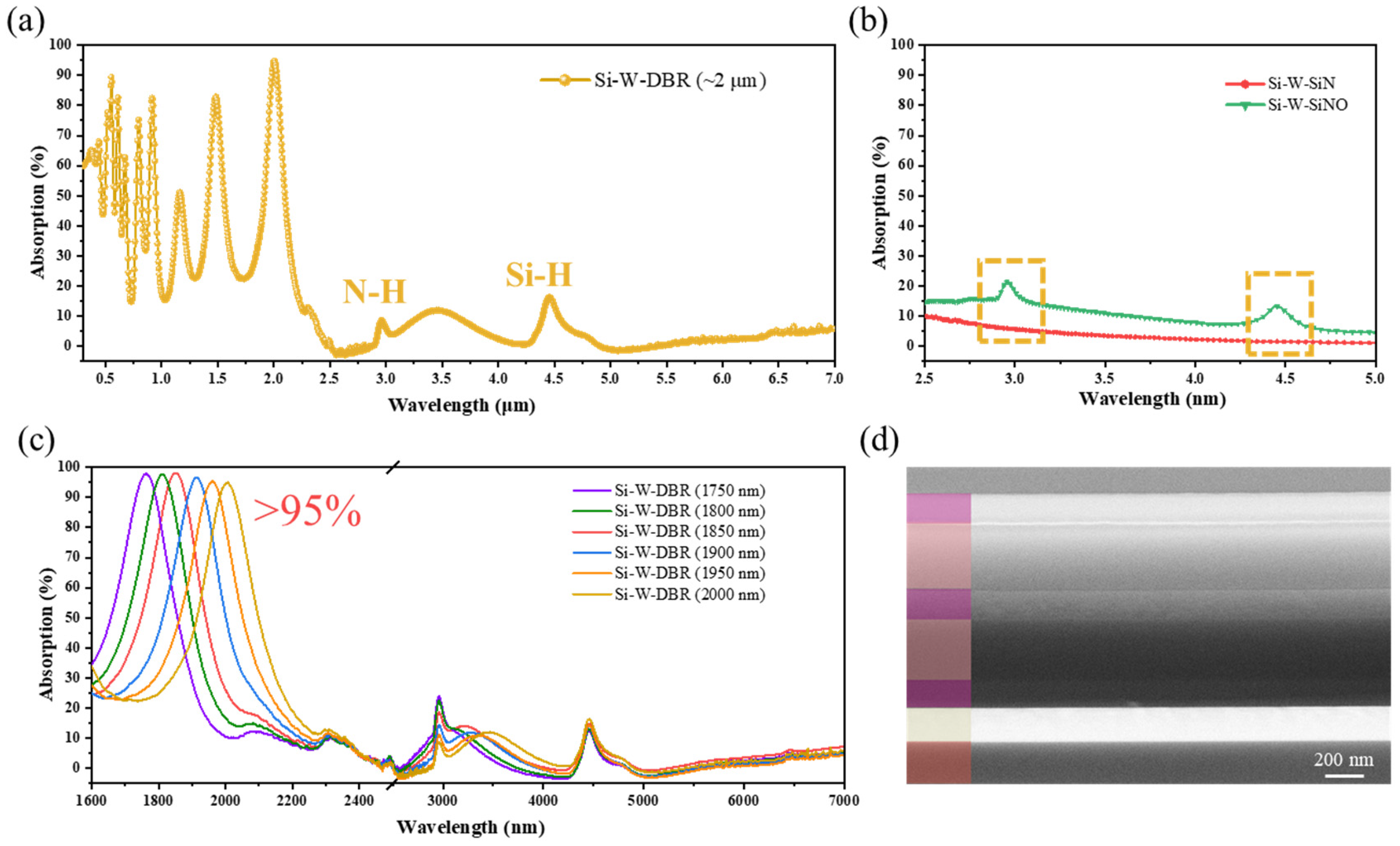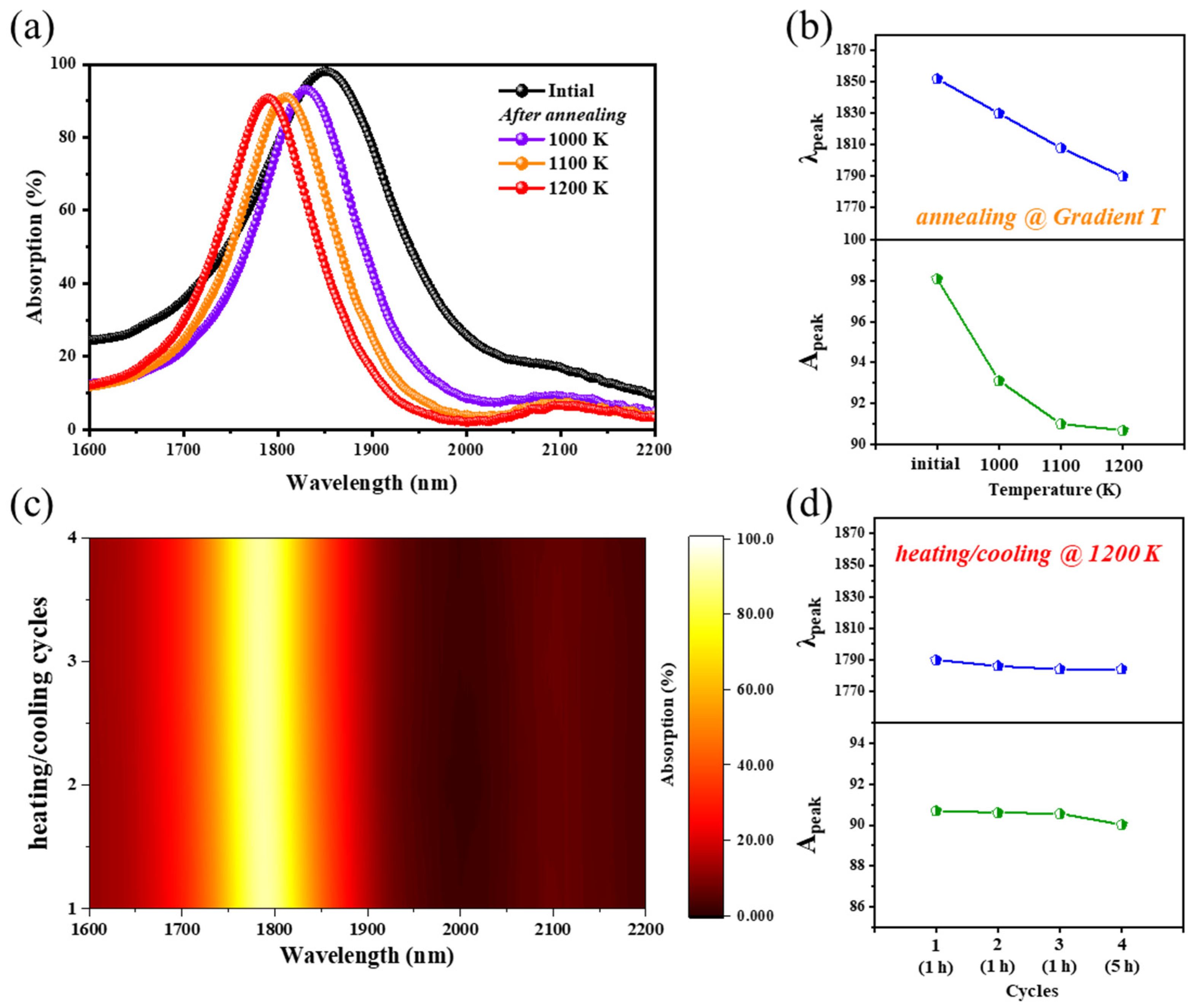Tunable Narrowband Silicon-Based Thermal Emitter with Excellent High-Temperature Stability Fabricated by Lithography-Free Methods
Abstract
:1. Introduction
2. Materials and Methods
3. Results and Discussion
4. Conclusions
Supplementary Materials
Author Contributions
Funding
Conflicts of Interest
References
- Jeon, N.; Hernandez, J.J.; Rosenmann, D.; Gray, S.K.; Martinson, A.B.F.; Foley Iv, J.J. Pareto Optimal Spectrally Selective Emitters for Thermophotovoltaics via Weak Absorber Critical Coupling. Adv. Energy Mater. 2018, 8, 1801035. [Google Scholar] [CrossRef]
- Bhatt, R.; Kravchenko, I.; Gupta, M. High-efficiency solar thermophotovoltaic system using a nanostructure-based selective emitter. Sol. Energy 2020, 197, 538–545. [Google Scholar] [CrossRef]
- Kim, Y.; Kim, M.-J.; Kim, Y.-S.; Lee, H.; Lee, S.-M. Nanostructured Radiation Emitters: Design Rules for High-Performance Thermophotovoltaic Systems. ACS Photonics 2019, 6, 2260–2267. [Google Scholar] [CrossRef]
- Rana, A.S.; Zubair, M.; Danner, A.; Mehmood, M.Q. Revisiting tantalum based nanostructures for efficient harvesting of solar radiation in STPV systems. Nano Energy 2021, 80, 105520. [Google Scholar] [CrossRef]
- Kim, H.; McSherry, S.; Brown, B.; Lenert, A. Selectively Enhancing Solar Scattering for Direct Radiative Cooling through Control of Polymer Nanofiber Morphology. ACS Appl. Mater. Interfaces 2020, 12, 43553–43559. [Google Scholar] [CrossRef] [PubMed]
- Li, D.; Liu, X.; Li, W.; Lin, Z.; Zhu, B.; Li, Z.; Li, J.; Li, B.; Fan, S.; Xie, J.; et al. Scalable and hierarchically designed polymer film as a selective thermal emitter for high-performance all-day radiative cooling. Nat. Nanotechnol. 2020, 16, 153–158. [Google Scholar] [CrossRef] [PubMed]
- Qu, Y.; Pan, M.; Qiu, M. Directional and Spectral Control of Thermal Emission and Its Application in Radiative Cooling and Infrared Light Sources. Phys. Rev. Appl. 2020, 13, 064052. [Google Scholar] [CrossRef]
- Park, C.; Kim, J.; Hahn, J.W. Selective Emitter with Engineered Anisotropic Radiation to Minimize Dual-Band Thermal Signature for Infrared Stealth Technology. ACS Appl. Mater. Interfaces 2020, 12, 43090–43097. [Google Scholar] [CrossRef] [PubMed]
- Lee, N.; Kim, T.; Lim, J.-S.; Chang, I.; Cho, H.H. Metamaterial-Selective Emitter for Maximizing Infrared Camouflage Performance with Energy Dissipation. ACS Appl. Mater. Interfaces 2019, 11, 21250–21257. [Google Scholar] [CrossRef]
- Zhu, H.; Li, Q.; Zheng, C.; Hong, Y.; Xu, Z.; Wang, H.; Shen, W.; Kaur, S.; Ghosh, P.; Qiu, M. High-temperature infrared camouflage with efficient thermal management. Light Sci. Appl. 2020, 9, 60. [Google Scholar] [CrossRef]
- Zhang, K.; Huang, Y.; Shen, Y.J.; Ma, S.; Chen, T.T. Combination of imine bond and samarium emitter enables turn-off fluorescence detection of hydrazine in vapor and water samples. Talanta 2021, 225, 122065. [Google Scholar] [CrossRef] [PubMed]
- Xu, R.; Lin, Y.S. Tunable Infrared Metamaterial Emitter for Gas Sensing Application. Nanomaterials 2020, 10, 1442. [Google Scholar] [CrossRef]
- Li, N.; Yuan, H.; Xu, L.; Tao, J.; Ng, D.K.T.; Lee, L.Y.T.; Cheam, D.D.; Zeng, Y.; Qiang, B.; Wang, Q.; et al. Radiation Enhancement by Graphene Oxide on Microelectromechanical System Emitters for Highly Selective Gas Sensing. ACS Sens. 2019, 4, 2746–2753. [Google Scholar] [CrossRef] [PubMed]
- Sakr, E.S.; Zhou, Z.; Bermel, P. High efficiency rare-earth emitter for thermophotovoltaic applications. Appl. Phys. Lett. 2014, 105, 111107. [Google Scholar] [CrossRef]
- Torsello, G.; Lomascolo, M.; Licciulli, A.; Diso, D.; Tundo, S.; Mazzer, M. The origin of highly efficient selective emission in rare-earth oxides for thermophotovoltaic applications. Nat. Mater. 2004, 3, 632–637. [Google Scholar] [CrossRef]
- Greffet, J.J.; Carminati, R.; Joulain, K.; Mulet, J.P.; Mainguy, S.; Chen, Y. Coherent emission of light by thermal sources. Nature 2002, 416, 61–64. [Google Scholar] [CrossRef]
- Doiron, C.F.; Naik, G.V. Non-Hermitian Selective Thermal Emitters using Metal-Semiconductor Hybrid Resonators. Adv. Mater. 2019, 31, e1904154. [Google Scholar] [CrossRef]
- Rinnerbauer, V.; Lenert, A.; Bierman, D.M.; Yeng, Y.X.; Chan, W.R.; Geil, R.D.; Senkevich, J.J.; Joannopoulos, J.D.; Wang, E.N.; Soljačić, M.; et al. Metallic Photonic Crystal Absorber-Emitter for Efficient Spectral Control in High-Temperature Solar Thermophotovoltaics. Adv. Energy Mater. 2014, 4, 1400334. [Google Scholar] [CrossRef]
- De Zoysa, M.; Asano, T.; Mochizuki, K.; Oskooi, A.; Inoue, T.; Noda, S. Conversion of broadband to narrowband thermal emission through energy recycling. Nat. Photonics 2012, 6, 535–539. [Google Scholar] [CrossRef]
- Fleming, J.G.; Lin, S.Y.; El-Kady, I.; Biswas, R.; Ho, K.M. All-metallic three-dimensional photonic crystals with a large infrared bandgap. Nature 2002, 417, 52–55. [Google Scholar] [CrossRef] [PubMed]
- Liu, G.; Liu, Y.; Liu, X.; Chen, J.; Fu, G.; Liu, Z. Large-area, low-cost, ultra-broadband, infrared perfect absorbers by coupled plasmonic-photonic micro-cavities. Sol. Energy Mater. Sol. Cells 2018, 186, 142–148. [Google Scholar] [CrossRef]
- Dao, T.D.; Chen, K.; Ishii, S.; Ohi, A.; Nabatame, T.; Kitajima, M.; Nagao, T. Infrared Perfect Absorbers Fabricated by Colloidal Mask Etching of Al–Al2O3–Al Trilayers. ACS Photonics 2015, 2, 964–970. [Google Scholar] [CrossRef]
- Liu, X.; Tyler, T.; Starr, T.; Starr, A.F.; Jokerst, N.M.; Padilla, W.J. Taming the blackbody with infrared metamaterials as selective thermal emitters. Phys. Rev. Lett. 2011, 107, 045901. [Google Scholar] [CrossRef]
- Zhou, J.; Liu, Z.; Liu, X.; Fu, G.; Liu, G.; Chen, J.; Wang, C.; Zhang, H.; Hong, M. Metamaterial and nanomaterial electromagnetic wave absorbers: Structures, properties and applications. J. Mater. Chem. C 2020, 8, 12768–12794. [Google Scholar] [CrossRef]
- Abdullah, H.; Islam, M.R.; Ahmed, K.; Malka, D.; Nguyen, T.K.; Hossain, M.N.; Paul, B.K.; Dhasarathan, V. Theoretical analysis of highly temperature-sensitive fem based optical sensor in the infrared range. Optik 2020, 205, 164060. [Google Scholar] [CrossRef]
- Malka, D. A Four Green TM/Red TE Demultiplexer Based on Multi Slot-Waveguide Structures. Materials 2020, 13, 3219. [Google Scholar] [CrossRef] [PubMed]
- Moshaev, V.; Leibin, Y.; Malka, D. Optimizations of Si PIN diode phase-shifter for controlling MZM quadrature bias point using SOI rib waveguide technology. Opt. Laser Technol. 2021, 138, 106844. [Google Scholar] [CrossRef]
- Singh, M.R.; Black, K. Anomalous Dipole–Dipole Interaction in an Ensemble of Quantum Emitters and Metallic Nanoparticle Hybrids. J. Phys. Chem. C 2018, 122, 26584–26591. [Google Scholar] [CrossRef]
- Singh, M.R.; Brzozowski, M.J.; Apter, B. Effect of phonon-plasmon and surface plasmon polaritons on photoluminescence in quantum emitter and graphene deposited on polar crystals. J. Appl. Phys. 2016, 120, 124308. [Google Scholar] [CrossRef]
- Singh, M.R.; Guo, J.; J. Cid, J.M.; De Hoyos Martinez, J.E. Control of fluorescence in quantum emitter and metallic nanoshell hybrids for medical applications. J. Appl. Phys. 2017, 121, 094303. [Google Scholar] [CrossRef]
- Singh, M.R.; Yastrebov, S. Switching and Sensing Using Kerr Nonlinearity in Quantum Dots Doped in Metallic Nanoshells. J. Phys. Chem. C 2020, 124, 12065–12074. [Google Scholar] [CrossRef]
- Bhatt, R.; Gupta, M. Design and validation of a high-efficiency planar solar thermophotovoltaic system using a spectrally selective emitter. Opt. Express 2020, 28, 21869–21890. [Google Scholar] [CrossRef] [PubMed]
- Yang, D.; Zhao, X.; Liu, Y.; Li, J.; Liu, H.; Hu, X.; Li, Z.; Zhang, J.; Guo, J.; Chen, Y.; et al. Enhanced thermal stability of solar selective absorber based on nano-multilayered AlCrSiO films. Sol. Energy Mater. Sol. Cells 2020, 207, 110331. [Google Scholar] [CrossRef]
- Tian, Y.; Liu, X.; Ghanekar, A.; Zheng, Y. Scalable-manufactured metal–insulator–metal based selective solar absorbers with excellent high-temperature insensitivity. Appl. Energy 2021, 281, 116055. [Google Scholar] [CrossRef]
- Du, K.; Cai, L.; Luo, H.; Lu, Y.; Tian, J.; Qu, Y.; Ghosh, P.; Lyu, Y.; Cheng, Z.; Qiu, M.; et al. Wavelength-tunable mid-infrared thermal emitters with a non-volatile phase changing material. Nanoscale 2018, 10, 4415–4420. [Google Scholar] [CrossRef]
- He, C.-Y.; Gao, X.-H.; Yu, D.-M.; Qiu, X.-L.; Guo, H.-X.; Liu, G. Scalable and highly efficient high temperature solar absorber coatings based on high entropy alloy nitride AlCrTaTiZrN with different antireflection layers. J. Mater. Chem. A 2021, 9, 6413–6422. [Google Scholar] [CrossRef]
- Doan, A.T.; Dao, T.D.; Ishii, S.; Nagao, T. Gires-Tournois resonators as ultra-narrowband perfect absorbers for infrared spectroscopic devices. Opt. Express 2019, 27, A725–A737. [Google Scholar] [CrossRef]
- Liu, X.; Li, Z.; Wen, Z.; Wu, M.; Lu, J.; Chen, X.; Zhao, X.; Wang, T.; Ji, R.; Zhang, Y.; et al. Large-area, lithography-free, narrow-band and highly directional thermal emitter. Nanoscale 2019, 11, 19742–19750. [Google Scholar] [CrossRef]
- Yang, Z.Y.; Ishii, S.; Yokoyama, T.; Dao, T.D.; Sun, M.G.; Nagao, T.; Chen, K.P. Tamm plasmon selective thermal emitters. Opt. Lett. 2016, 41, 4453–4456. [Google Scholar] [CrossRef]
- Yang, Z.-Y.; Ishii, S.; Yokoyama, T.; Dao, T.D.; Sun, M.-G.; Pankin, P.S.; Timofeev, I.V.; Nagao, T.; Chen, K.-P. Narrowband Wavelength Selective Thermal Emitters by Confined Tamm Plasmon Polaritons. ACS Photonics 2017, 4, 2212–2219. [Google Scholar] [CrossRef]
- Yang, Z.Y.; Ishii, S.; Doan, A.T.; Shinde, S.L.; Dao, T.D.; Lo, Y.P.; Chen, K.P.; Nagao, T. Narrow-Band Thermal Emitter with Titanium Nitride Thin Film Demonstrating High Temperature Stability. Adv. Opt. Mater. 2020, 8, 1900982. [Google Scholar] [CrossRef]
- Wang, Z.; Clark, J.K.; Ho, Y.-L.; Volz, S.; Daiguji, H.; Delaunay, J.-J. Ultranarrow and Wavelength-Tunable Thermal Emission in a Hybrid Metal–Optical Tamm State Structure. ACS Photonics 2020, 7, 1569–1576. [Google Scholar] [CrossRef]
- Kaliteevski, M.; Iorsh, I.; Brand, S.; Abram, R.A.; Chamberlain, J.M.; Kavokin, A.V.; Shelykh, I.A. Tamm plasmon-polaritons: Possible electromagnetic states at the interface of a metal and a dielectric Bragg mirror. Phys. Rev. B 2007, 76, 165415. [Google Scholar] [CrossRef]
- Streyer, W.; Feng, K.; Zhong, Y.; Hoffman, A.J.; Wasserman, D. Selective absorbers and thermal emitters for far-infrared wavelengths. Appl. Phys. Lett. 2015, 107, 081105. [Google Scholar] [CrossRef]
- Singh, M.R.; Brassem, G.; Yastrebov, S. Enhancement of Radiative and Nonradiative Emission in Random Lasing Plasmonic Nanofibers. Ann. Phys. 2021, 533, 2000558. [Google Scholar] [CrossRef]
- Singh, M.R.; Brassem, G.; Yastrebov, S. Optical quantum yield in plasmonic nanowaveguide. Nanotechnology 2021, 32, 135207. [Google Scholar] [CrossRef]
- Rui, Y.; Li, S.; Xu, J.; Song, C.; Jiang, X.; Li, W.; Chen, K.; Wang, Q.; Zuo, Y. Size-dependent electroluminescence from Si quantum dots embedded in amorphous SiC matrix. J. Appl. Phys. 2011, 110, 064322. [Google Scholar] [CrossRef]
- Lu, P.; Mu, W.; Xu, J.; Zhang, X.; Zhang, W.; Li, W.; Xu, L.; Chen, K. Phosphorus Doping in Si Nanocrystals/SiO2 multilayers and Light Emission with Wavelength compatible for Optical Telecommunication. Sci. Rep. 2016, 6, 22888. [Google Scholar] [CrossRef]





Publisher’s Note: MDPI stays neutral with regard to jurisdictional claims in published maps and institutional affiliations. |
© 2021 by the authors. Licensee MDPI, Basel, Switzerland. This article is an open access article distributed under the terms and conditions of the Creative Commons Attribution (CC BY) license (https://creativecommons.org/licenses/by/4.0/).
Share and Cite
Hou, G.; Wang, Q.; Zhu, Y.; Lu, Z.; Xu, J.; Chen, K. Tunable Narrowband Silicon-Based Thermal Emitter with Excellent High-Temperature Stability Fabricated by Lithography-Free Methods. Nanomaterials 2021, 11, 1814. https://doi.org/10.3390/nano11071814
Hou G, Wang Q, Zhu Y, Lu Z, Xu J, Chen K. Tunable Narrowband Silicon-Based Thermal Emitter with Excellent High-Temperature Stability Fabricated by Lithography-Free Methods. Nanomaterials. 2021; 11(7):1814. https://doi.org/10.3390/nano11071814
Chicago/Turabian StyleHou, Guozhi, Qingyuan Wang, Yu Zhu, Zhangbo Lu, Jun Xu, and Kunji Chen. 2021. "Tunable Narrowband Silicon-Based Thermal Emitter with Excellent High-Temperature Stability Fabricated by Lithography-Free Methods" Nanomaterials 11, no. 7: 1814. https://doi.org/10.3390/nano11071814
APA StyleHou, G., Wang, Q., Zhu, Y., Lu, Z., Xu, J., & Chen, K. (2021). Tunable Narrowband Silicon-Based Thermal Emitter with Excellent High-Temperature Stability Fabricated by Lithography-Free Methods. Nanomaterials, 11(7), 1814. https://doi.org/10.3390/nano11071814






